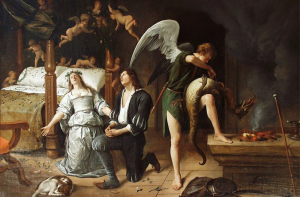
 FTER the Rite of Marriage is completed in the Nuptial Mass, the rest seems almost anticlimactic. You know, it’s just the miracle whereby the Creator of the universe is consumed by us under the appearance of bread and wine. No big deal.
FTER the Rite of Marriage is completed in the Nuptial Mass, the rest seems almost anticlimactic. You know, it’s just the miracle whereby the Creator of the universe is consumed by us under the appearance of bread and wine. No big deal.
Snarkiness aside (fat chance), the Liturgy of the Eucharist seems like no big deal because it is so much more routine to us. We have to be careful not to neglect it as “just the Mass” from this point on, because there is nothing routine about the Mass, at least not in the dull, lifeless sense. Just as we seek beauty and excellent worship in our normal parish liturgy, so should we seek it in the Nuptial Mass. Remember that the congregation at this Mass is probably from far and wide, so the Mass Ordinary that works so well on the weekends might draw a dud response from this group. Keep it simple. The Missal chants are pretty well known across the country right now (a great blessing from the new translation). Even though the adaptations of these chants are, in my opinion anyway, not particularly inspired, they are a good common repertoire for these kinds of Masses. They are much better than many of the newer settings pushed by the major publishers, to be sure.
One custom that has worked its way into the Nuptial Mass, toward the end, is the presentation of flowers to an image of the Blessed Virgin Mary. While I am reluctant to discourage any kind of devotion to Our Lady, this probably isn’t the best time for it. It would be much better placed at the rehearsal, or even directly after Mass. Private devotions like this are not particularly suited to the public act of the Mass. That said, there are far worse corruptions that have wormed their way into the wedding liturgy.
The rest is easy. While Mass should never be mindlessly easy, we are still back in the comfort zone at this point. As an additional point of advice, now that I consider the mixed congregation we have at these liturgies, is to make a good worship aid. I don’t mean the little card programs that get handed out, the “cast of characters” that make sure everyone knows who the 8th bridesmaid processing down the aisle is. I mean a full blown, texts-and-music order of service, including the full spoken responses for the congregation. If these texts are available in a hymnal or missal in the pews (I have no idea where you could find a good one of those), then that can function, too. Just make sure the congregation is made aware of these texts before the liturgy starts. Many of them are not Catholic, and some that are have not darkened the doors of a church in some time. Make them welcome and help them re-acclimate to the liturgy. For that matter, including the norms for receiving Holy Communion is a good idea, too.
I know it’s a grand cliche, but remember that this sacrament is the beginning, not the end, of a couple’s journey together toward salvation. Too often it is seen as the goal line, and “happily ever after” is the end of the story. That’s one of the reasons people overdo it with all the bells and whistles at their wedding. Put more effort into your marriage than into your wedding, and you’ll be much more successful.
And by the way, congratulations to my baby sister, Laurie, who is getting married this weekend.

